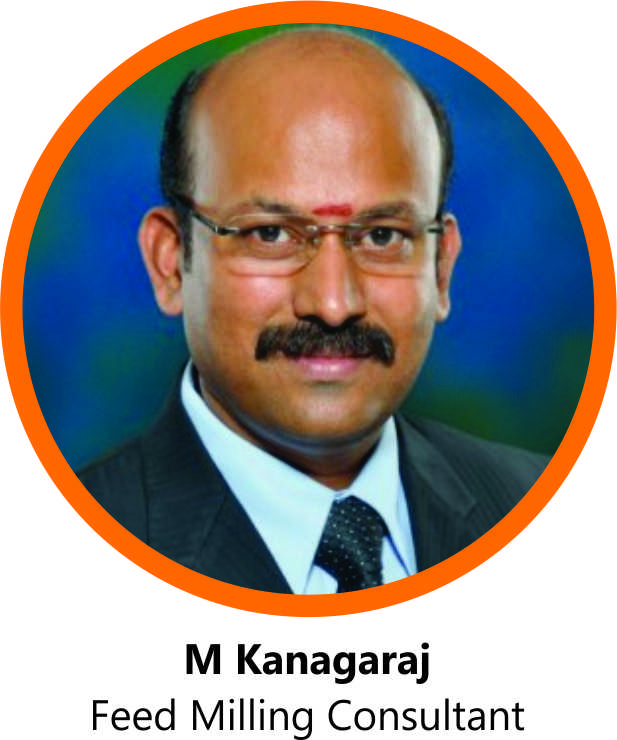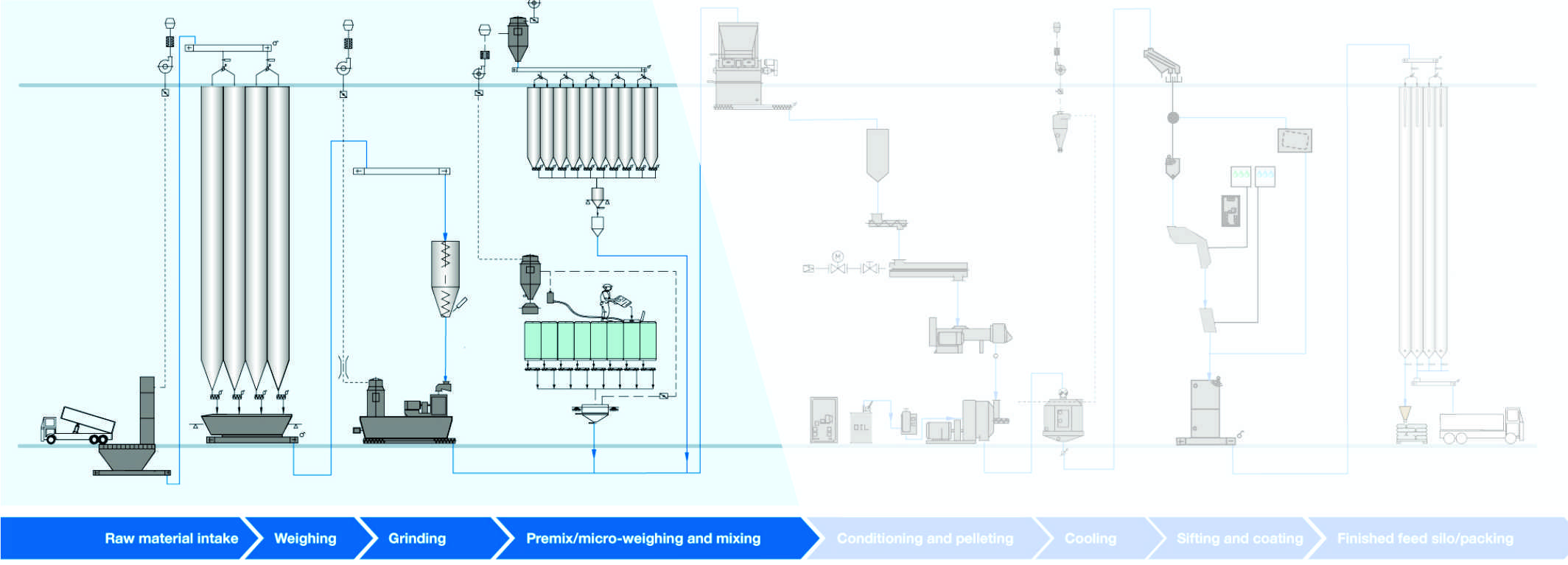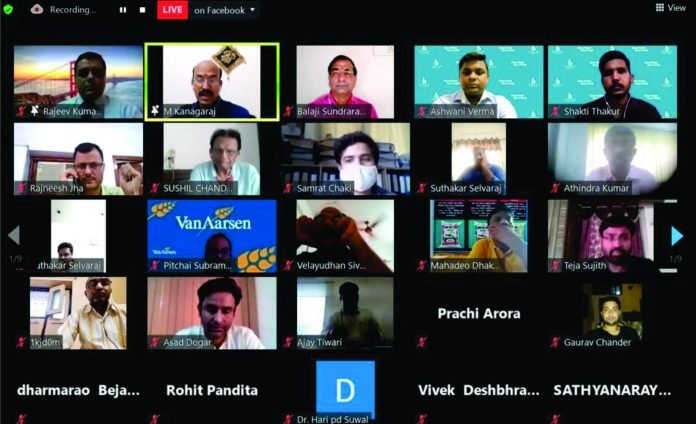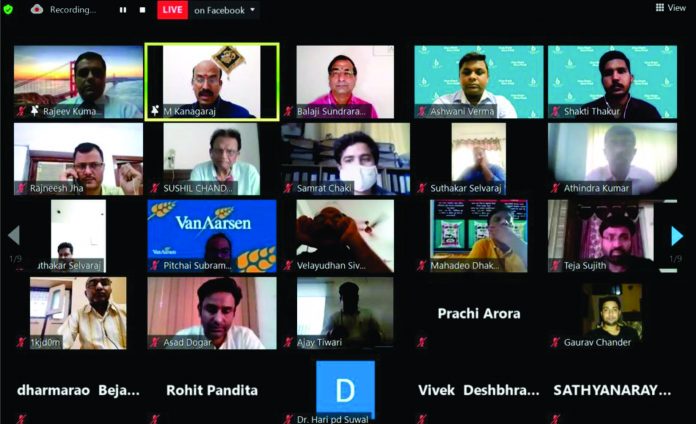Think Grain Think Feed organized first session of Process Optimization webinar on 28th May with Mr M. Kanagaraj – a renowned Feed Milling expert who has trained more than 1,000 feed mill professionals from integrators, commercial feed manufacturers and others in the 

What are the non-value-added activities in a feed mill?
RS: Converting raw material to the end product by using resources is value addition but wastage happening during the process also utilizes the same resources which brings no value and is defined as non-value-added activities in the process. Eliminating these non-value additions can bring better efficiency and product quality too.


Inventory – If there is shortage of raw material then production is held up and capacity utilization is not up to the mark due to which all fixed and variable cost multiplies. The thumb rule for the capacity utilization is unloading capacity. It should be higher than intake capacity, which should be higher than batching, it should be higher than the grinding and mixing and that should be more than the pelleting. If the thumb rule is followed properly then the succeeding process won’t be held up because of the non-supply of flow of material from the previous system.
Over-production in hammer mills – If mixer is not able to handle the capacity of the hammer mill, then the hammer mill would run idle which would be a wastage of energy with more wear and tear to the machine, etc. This can be avoided by finetuning the hammer mill capacity.
Production scheduling – Without proper scheduling, a greater number of changeovers or number of products produced in a day would require more time gap which is again a wastage.
There are many benefits of process optimization, one of the most important is consistency. Consistency brings predictability and with predictability, planning can be done with minute details.
What are the challenges in managing the inventory in a manner that it should not exceed but also a minimum inventory level is maintained?


Keeping the inventory to match the production is also challenging. If one can reduce the warehouse space up to 50% then inventory can be automatically managed. For inventory management, data analysis is the key. By data compilation and analysis to understand the movement of raw material in terms of its availability, quantity, and price, etc., one can understand how the market is responding to different seasons which would bring demand versus production season analysis.
Availability of raw material and demand in the market cannot be controlled hence it is important to make correct forecast and manage operations accordingly. Inventory management is crucial for any feed miller to control the price and quality of the entire feed mill.
Reducing space usage by 50% may result in shortage of raw material. How a feed miller can overcome that?
BS: In scarcity, one tends to buy more as observed in the pandemic time. If there is more space, one tends to buy more without proper planning and logistics in place which is a wastage. With more resources people become resourceless while with fewer resources they become resourceful.
We follow this in RGS Feeds. Say if per week production is 400 MT with 20% downtime then monthly production would be 10,000 or 11,000 MT. As per planning, the monthly requirement is given and the basis upon which orders are placed on weekly basis to get raw materials at exact time. There is a possibility of keeping the product in the suppliers’ godown instead of its own space while ensuring to pick it on a particular date.
How grain handling solutions can help feed manufacturers to optimize their resources in terms of money and inventory?


Grain storage is again a vital aspect of a feed mill. Silos should be planned with complete engineering i.e., proper accessories, aeration, temperature control, fumigation, recleaning of material, recirculation of material etc. It can be a value-added activity for any grain processing industry.
Usually, hammer mills overproduce whereas pellet mills remain full, and hence, hammer mill is to be stopped. What is the reason?


Over-production in a hammer mill can be due to various factors like the kind of material proposition in the formulation when it consists of more grains it would take a longer time for grinding. Also, pushing all powder material through hammer mill increases the grinding time and also power consumption which also results in non-uniform particle size reduction. By using a sieve before the hammer mill, the finer material can bypass the hammer mill and directly come into the mixer.
The mixing cycle including wet mixing time, dry mixing time, liquid addition, the sequence of material adding to the mixer is again important. If it is decided properly at the design level itself delay can be avoided.
How does the over-production in hammer mill affect the overall efficiency?
RT: One should have proper planning in place starting from outlet of batching up to outlet of mixer. In case a feed miller still faces problem, a technique is followed while designing any type of flow diagram is Mixing Cycle Diagram. This diagram considers the conveyor capacity, conveyor discharge time, discharge time from a hopper, various scales, idle time and with detailed planning even the number of batches to be produced on an hourly basis is known. Considering all these factors, if it is a good mixing cycle diagram then the hammer mill will never over-produce or run out of production.
How to reduce the idle time in feed milling?
BS: To overcome idle time or over-production in hammer mill, firstly one should understand the hammer mill i.e., variance versus the hammer mill behavior. Secondly, people should be completely trained to understand the variation then act accordingly.
All machinery should be at the optimum level. One should proportionate sieve versus die, it is important to understand the particle size entering the hammer mill and coming out of the hammer mill. Complete information like mixing time, moisture, mixing cycle, etc. should be collected and then the production should be started. By doing so one would reduce the idle time in production. Otherwise, this idle time can be up to 7% of entire milling operations which is reduced up to 3% in our case.
The process standards will vary in a micro level from one feed mill to other due to factors such as change in environment, procurement methodology etc. Would you share your views on grinding process standardization?
RS: Standardization is specific to the unit or company or maybe even to the suppliers of the equipment. But from a larger perspective, a hammer mill is used for particle size reduction, one can standardize the speed of the hammer mill like the modern feed plants have 2800-3000 RPM which is standard followed by most of the feed equipment suppliers.
Also, selection of the sieve is important, if one is producing a 3mm pellet then one (should use sieve above the hammer mill) or tries to reduce the particle size less than 3mm. It is not a hard and fast rule but basis upon experience one can design the standard.
RT: Using sieve above the hammer mill is a very good approach which is used in all feed plants in Europe and recently has been adopted in India. This approach helps to optimize the energy consumption in hammer mill. Different kind of process adoption in a feed mill requires different kinds of hammer mill like vertical, horizontal etc. but the basic principle behind hammer mill optimization is to know particle size distribution range and D50 value. If these two inputs are given while designing the plant then hammer mill would run 100% in an optimum manner.
How much is the energy consumption in a hammer mill?
RT: In case of vertical hammer mill, coarser grinding is expected hence there is 15-20% less energy consumption is there in the hammer mill not in the whole process.
Share your experience on mixing process standardization especially in a country like ours where there is lot of similarity in the process like oil inclusion or using large quantities of molasses?
RT: Mixing Cycle Diagram is a very versatile tool to standardize the mixing operation for any particular kind of product which is to be produced. Up to the mixer it is a batch process and after mixer it is a continuous process. If the mixing cycle diagram up to the mixer is followed firmly then one can know the mixing time for different kinds of products and it can be standardized.
AUDIENCE QUESTIONS
In a humid climate, the moisture content in feed gets above 11% thereby reducing the shelf life. How to manage the moisture above the standard of 11%?
RS: The moisture level depends upon the moisture of your input raw material, if it is above 11% then one should make necessary adjustment in the post-pelleting process, particularly in the cooling process. One is adjusting the material at the bed level of the cooler there would be better cooling process. Second is the opening of the damper of the butterfly valve near the blower, by adjusting its airflow can be increased or reduced and excess moisture can be absorbed. Third is bypassing the dry air in the inlet of the cooler which is not common in feed milling but it is practiced in oil milling where hot air is passed through the cooler so that excess moisture can be removed. It can be added to the feed mill also.
Your opinion about cost optimization
BS: Firstly, a feed miller needs to understand that 85-88% of the output is raw material. The first step for cost optimization is to optimize the purchasing or the formula for the product. Secondly, there are two important factors for process cost reduction are energy and human resources. For energy, you need to look into non-value-added factors like power cost. By controlling idle running of hammer mill, pellet mill, conveyors and other parts, you may reduce the cost of energy. Human resources are most important and after some surveys, we have reduced 20% of our human resources while increasing 40% of our productivity.
For costing, one has to go as per batch or formula or product. One should be able to recognize the formula giving the best results and move in that direction. There can be a lot of variability like one formula can give 13 MT per hour while other can give 17 MT per hour. Costing is to be made with every batch.
What all seasonal precautions should be taken care by the feed industry?
RS: In India, we experience extreme kinds of climate like cold weather to severe-heat condition in summer. We should take few precautions at the time of storage. In an open storage facility, there is a lot of moisture loss happening in peak summer, one should store lesser quantities during that time.
Steam is another neglected area in feed milling, in winter the temperature is low and steam gets condensate due to which enough temperature is not maintained for the pelleting process, so to avoid such conditions one should properly insulate the steam line.
BS: Feed manufacturing operations and cost optimization does not have any seasonal precaution or activity.
Control the efficacy of the system, machine, and manpower within a set means.
Improve your production to zero defects and zero downtime.
How much losses occur in the feed milling process due to atmospheric conditions?
RS: There are two kinds of shortages, one is storage shortage – the shortage happening during storage of the raw material like handling shortage, transportation shortage; second is the process loss which starts from intake of material to bagging. If both combined would be less than 1% then it represents an efficient feed mill.
Moisture loss is the main factor affecting inventory control and moisture shrinkage results in differences between documented and actual stock especially in terms of grains. How should we control?
RS: Moisture loss during the storage is inevitable, especially when material is stored for longer period. Take utmost care while accepting the raw materials particularly high moisture materials. If it is unavoidable, better to consume the grains having high moisture at the earliest, but following FIFO (First In First Out) system is most desirable.
What are the process loss and shrinkage loss standard % for the poultry industry?
RS: Process loss and Storage loss again depend on the moisture levels of input materials. So always better to have more control on the input materials. In this time of high-cost raw materials, minimization of the loss is paramount importance. For computation of costing, we can keep a provision of maximum 1.0%. Moisture optimization systems available in the industry can minimize the shrinkage or process loss.
Factors to be considered to stock ingredients in bulk storage especially in silos with optimum quality for 3-4 months.
RS: While storing Grains in the bulk storage system, some points to be taken into consideration to keep the stock in good conditions are:
- Do not load high moisture (above 12.0%) grain to the silo.
- Silo should be facilitated with aeration system, and operate at least an hour every day.
- To prevent mold growth, mold inhibitors may be sprayed on the material during intake.
- Completely empty out the silo at least once in 3-4 months.
- No leakages / water seepage in the silo wall or foundation.
In the commodity market strategic stocking is required in the feed business? What should be the concept for strategic stocking?
BS: Increasing stock level ensures availability of materials and happy customers but holding inventories can be costly and reduces operational fund.
- Design a budget for your inventory to meet your availability service level.
- Create a minimum quantity level for inventories to produce different product to meet your customer demand.
- Measure the inventory’s usage & identify the factors that lead to over & understocking.
- Analyze individual SKU’s volatility & viability in storage.
Conclusions
Process optimization is one of the key aspects that every feed miller should practice and tune the process as close as possible to the requirement. Below are the take home message from this session:
- Trained labor in right quantity is the key. More labor or shortage of labor would affect the productivity of the feed plant.
- Transport equipment capacity should match with the key equipment capacity rather it should be more.
- Data collection and analysis would bring real results whether it is quality or any other parameter.
- Reduce your warehouse space, try to bring it to 50%.
- Grain cleaning is very important whether you store it in silo or bags.
Note: PART II of PROCESS OPTIMIZATION webinar is scheduled on 23rd July to register click here: https://bit.ly/3wBXOCA













